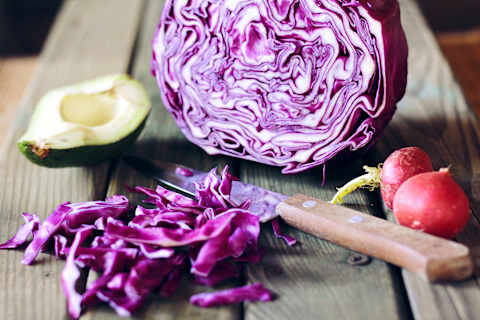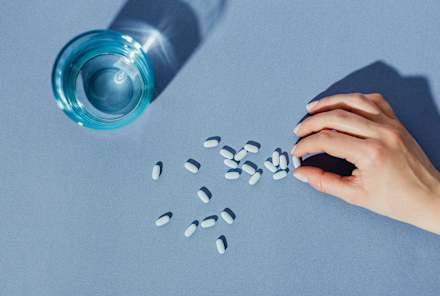Advertisement

The term "detox diet" is broad, divisive, and often conjures thoughts of cleanses featuring cayenne-laced lemon water that promise to curb cravings, boost energy, and help you lose weight. Many people are quick to say they’re all a hoax, too, since the body is more than capable of taking care of itself, thanks to our built-in detoxification system starring the liver.
But while our liver is always detoxifying our bloodstream, it’s not necessarily working optimally. The truth is, our bodies aren’t necessarily equipped to deal with the burden they’re now facing. Today, more than ever, we’re bombarded with countless toxins—from pollution to chemicals in skin care products to (perhaps most of all) sugar and preservatives in the foods we eat. These can throw blood sugar totally out of whack, deplete nutrient stores, cause a buildup of dangerous substances in the body like heavy metals, and lead to chronic inflammation—all of which can make us tired and sick. And we’ll continue to feel this way unless we make a shift.
While we can’t necessarily control the world around us or our exposure to all pollutants and chemicals, we can make strategic dietary changes that will help counter their effects by supporting the liver, reducing inflammation, healing the gut, balancing blood sugar, and lightening our overall toxic load. This, in broad terms, is what a detox diet should do.
Signs and symptoms you should try a detox diet
Think back to the time in your life when you felt the healthiest. How does your current state compare? If you feel significantly less vital, or you’ve never felt that great to begin with, it could be time to try a detox. Here are some specific signs it’s time to make a change:
- You crave sugar and carbs
- You experience digestive distress like bloating
- You feel spacey or foggy
- You’re always exhausted
- Your joints are achy
- You’re stressed, depressed, or anxious
- You can’t lose weight
- You have trouble sleeping
- You can’t concentrate
What to eat on a detox diet
A common misconception is that detox diets must be extreme or that they’re expensive or that they’re all green juice misery—but this doesn’t have to be the case. In fact, they can (and often should!) resemble a pretty simple, balanced, whole-foods-based diet. No pricey prepackaged meals required.
Since there’s no official definition of "detox diet," the suggestions and foods below should be considered a framework that can be customized based on your specific needs and preferences rather than a set of strict rules.
Step 1: Start with a strong, whole-foods-based diet.

A good first step is ditching the packaged foods and focusing on whole, preferably organic foods like vegetables, fruits, whole grains, beans, nuts, seeds, sustainably raised meats, fish, eggs, and minimally processed oils such as olive or coconut oil.
This means you’ll be taking a break from most of the foods and additives that tax your system (e.g., added sugars or artificial sweeteners, refined carbohydrates, trans fats), as well as some chemical pesticides from conventional produce, and adding in nutrient-dense foods that will nourish the body and keep blood sugar levels stable.
Step 2: Consider eliminating common food intolerances.
Sometimes the "toxins" that are making it more difficult for our bodies to function optimally are foods that we’re intolerant or allergic to, but we don’t know it yet. Allergies are more obvious and often involve swelling and trouble breathing. But intolerances and their symptoms are subtler and can trigger an inflammatory response in the gut that leads to full-body inflammation and symptoms such as diarrhea, constipation, bloating, eczema, joint aches, and migraines.
Common food intolerances include those to soy, gluten, corn, eggs, peanuts, shellfish, and dairy. If you have some of the symptoms above, consider eliminating potential trigger foods for a period of time (it usually takes a few weeks to notice a difference), preferably under the supervision of a doctor or registered dietitian. You’ll also want to eliminate alcohol since your body registers alcohol as a toxin and relies on your liver to process and eliminate it, which can put stress on the organ.
Step 3: Add in specific detox-friendly superfoods.
At this point, you have a great base diet full of nourishing whole foods. But now it’s time to get more strategic and add in specific foods that have been shown to improve digestion, heal the gut (since a leaky gut can allow unwanted toxins into the bloodstream), and support the liver or assist your body’s detoxification processes in other ways. These 12 are a great place to start:
1. Green tea
Here’s a great reason to make a morning cuppa matcha a habit. The phytochemicals in green tea have been shown to help trigger both phase-one and phase-two liver detoxification. In phase one, toxins are made water-soluble by enzymes; and in phase two, toxins are bound to protective chemicals that neutralize them and allow them to be eliminated via bile or urine. The polyphenol antioxidants in green tea are also anti-inflammatory and have cancer-preventing effects.
2. Dandelion
Not into green tea? Try sipping on dandelion root tea, sometimes called dandelion coffee, which is caffeine-free and tastes somewhat similar to actual coffee. Dandelion is famous for its cleansing properties, and one study1 found that it helped rid the body of reactive oxygen species that cause oxidative stress, which reduced risk of atherosclerosis (deposits of plaque within arteries). Dandelion greens are great too, as they can help stimulate bile production and promote healthy digestion.
3. Lemon water
Turns out that lemon water really is a great way to start the day. Lemons—along with other forms of citrus such as tangerines and oranges—contain a compound called D-limonene, which has been shown to help reverse oxidative damage2 caused to the liver as a result of a high-fat diet. Sipping on lemon water throughout the day is also a great way to stay hydrated, which helps promote the movement of toxins out of the body.
4. Leafy greens
Dark leafy greens such as dandelion greens, arugula, spinach, and kale (and even algaes like chlorella) contain plant chlorophylls, which help remove chemicals, pesticides, and heavy metals from the bloodstream. Specifically, early research3 shows that chlorophyll may reduce the risk of liver damage caused by aflatoxins (dangerous compounds produced by fungi that may be present on a variety of foods, including peanuts) by increasing the activity of certain enzymes and removing toxins.
5. Algae
Chlorella, specifically, is a powerful chelator, and has been shown to absorb 40 percent of the heavy metals in the test solution within seven days. Consider adding a scoop to your morning smoothie for a detoxifying boost. Need some inspiration? Try this recipe.
6. Cruciferous vegetables

Cruciferous veggies such as broccoli, cabbage, cauliflower, and Brussels sprouts contain sulfur-containing phytochemicals called glucosinolates, which are protective against cancer, anti-inflammatory, and may help the body remove toxins. One study found that a drink made with broccoli activated enzymes that helped pick up pollutants from the bloodstream and flush them out via urine. Cruciferous veggies are also high in fiber, which helps feed "good" probiotic gut bacteria and promote digestion. That’s critical, since a damaged (or leaky) gut allows various toxins and bacteria into the bloodstream, contributing to issues like systemic inflammation and autoimmune disease4.
7. Beets
These ruby-hued roots contain a type of antioxidant called betalains, which may help reduce chronic inflammation5 and repair cells in the liver thanks to their potent antioxidant and anti-inflammatory properties. Beets also boast high amounts of dietary nitrates, which expand blood vessels and improve blood flow, and thus lower blood pressure. Consider blending your beets with a peeled orange, splash of seltzer, and some ice for a refreshing treat.
8. Herbs and spices
If you’re experiencing digestive woes, consider parsley. This often-overlooked herb acts as a natural diuretic and helps prevent bloating. It also contains anti-inflammatory vitamin C. Cilantro is another great pick, as it can help remove heavy metals6 like mercury and lead from the body. Try adding both of these herbs to your morning smoothie. Want more of a kick? Go for ginger, an anti-inflammatory, antioxidant spice that promotes balanced blood sugar and optimal digestion. Or start using more garlic, which contains naturally detoxifying sulfur compounds (just like cruciferous veggies) and combats the growth of unfriendly bacteria in the gut.
9. Fermented foods
Sauerkraut, kimchi, kombucha, and other fermented foods are loaded with "good" probiotic bacteria, which promote healthy digestion and help promote a healthy, stable gut that keep toxins out of the bloodstream. And according to functional medicine experts like Dr. Frank Lipman, they may also help clear heavy metals out of the body.
10. Berries
If you’re craving a sweet treat on your detox, opt for deep-hued berries such as blueberries, blackberries, and raspberries. These are all relatively low-sugar and high-fiber, which means they’ll help keep blood sugar stable and cravings at bay. They’re also loaded with phytochemicals called anthocyanins, which are potent antioxidants that have been shown to scavenge free radicals, reduce inflammation, and boost brain health and mood.
11. Nuts and seeds
Nuts and seeds, particularly hemp, flax, and chia seeds, are rich in fiber and antioxidants, which help promote optimal digestion and move food through the body faster, which aids in toxin removal. Nuts are great, too; particularly walnuts, which are a great source of plant-based omega-3 fats, which reduce inflammation and may boost learning, memory7, and overall brain function.
12. Bone broth (and other glutathione boosting foods)
Glutathione is an antioxidant concentrated in the liver that helps bind toxins and escort them out of the body via urine or bile. Glutathione may also boost the absorption of various nutrients in the foods you eat. Glutathione can be obtained directly from a few foods, including raw spinach, avocado, and asparagus; and it can also be produced by your body from the amino acids glutamine, glycine, and cysteine. Foods containing the building blocks of glutathione include bone broth and sulfur-containing foods such as cruciferous veggies and garlic. Getting enough vitamin C, vitamin D, and minerals like zinc and selenium are also important for glutathione production.
The bottom line: Detoxes can be a healthy way to hit the reset button.
Our bodies are exposed to more toxins than ever, and a detox can be a healthy way to halt the damage. But contrary to popular belief, the best detoxes aren’t restrictive or unsustainable. One that involves eliminating packaged foods and including a variety of antioxidant-rich vegetables, fruits, whole grains, quality proteins, and some of the nutrient-rich foods mentioned above is a safe, long-term approach to living a more vibrant life.
Want more healthy eating? Try our Advanced Functional Nutrition training program.
7 Sources
- https://www.ncbi.nlm.nih.gov/pmc/articles/PMC2820990/
- https://www.ncbi.nlm.nih.gov/pubmed/21445622
- https://www.ncbi.nlm.nih.gov/pubmed/7788866
- https://www.ncbi.nlm.nih.gov/pmc/articles/PMC5440529/
- https://www.ncbi.nlm.nih.gov/pmc/articles/PMC4425174/
- https://www.ncbi.nlm.nih.gov/pubmed/8686573
- https://www.ncbi.nlm.nih.gov/pubmed/22048906
Watch Next
Enjoy some of our favorite clips from classes
Enjoy some of our favorite clips from classes
What Is Meditation?
Mindfulness/Spirituality | Light Watkins
Box Breathing
Mindfulness/Spirituality | Gwen Dittmar
What Breathwork Can Address
Mindfulness/Spirituality | Gwen Dittmar
The 8 Limbs of Yoga - What is Asana?
Yoga | Caley Alyssa
Two Standing Postures to Open Up Tight Hips
Yoga | Caley Alyssa
How Plants Can Optimize Athletic Performance
Nutrition | Rich Roll
What to Eat Before a Workout
Nutrition | Rich Roll
How Ayurveda Helps Us Navigate Modern Life
Nutrition | Sahara Rose
Messages About Love & Relationships
Love & Relationships | Esther Perel
Love Languages
Love & Relationships | Esther Perel


















